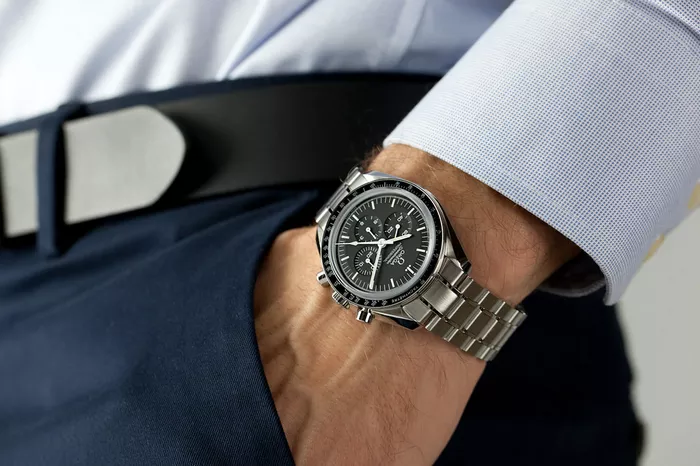The Omega Speedmaster Moonwatch stands as an icon in the world of horology, with a legacy intertwined with space exploration and historical significance. Renowned as the first watch worn on the moon during the Apollo 11 mission in 1969, the Moonwatch has transcended its initial purpose as a tool for astronauts and evolved into a symbol of precision, durability, and timeless design. In this comprehensive guide, we delve into the intricate details of the Omega Speedmaster Moonwatch, exploring its historical journey, design elements, technical specifications, and the enduring appeal that has captured the hearts of watch enthusiasts around the globe.
I. A Journey to the Moon and Beyond
The history of the Omega Speedmaster Moonwatch is inseparable from the space race of the 1960s. In 1965, after rigorous testing by NASA, the Speedmaster became the official watch for space missions, earning the “flight-qualified by NASA for all manned space missions” designation. However, its crowning achievement came in 1969 when astronaut Buzz Aldrin wore the Speedmaster during the Apollo 11 mission, marking the first timepiece on the lunar surface. This historic moment forever solidified the Moonwatch’s place in horological and space exploration history.
II. Design Elements and Aesthetic Timelessness
The Moonwatch’s design is a testament to functional elegance. Its enduring aesthetic features a black dial with contrasting white subdials, a tachymeter scale on the bezel, and distinctive “baton” hands and hour markers. The hesalite crystal, a type of acrylic, not only adds a vintage touch but also pays homage to the original Moonwatch. The stainless steel case, with its robust build and symmetrical design, reflects both the watch’s resilience and timeless appeal.
III. Manual Winding Caliber 1861 Movement
Powering the Moonwatch is the manual-winding Omega Caliber 1861 movement, a direct descendant of the original movement that accompanied the astronauts to the moon. This highly reliable and robust movement features a power reserve of approximately 48 hours and has become synonymous with the Moonwatch’s enduring precision. The decision to retain the manual-winding mechanism pays homage to the historical roots of the timepiece and ensures a tangible connection to the era of space exploration.
IV. Professional Chronograph Functionality
The Speedmaster Moonwatch is revered for its professional chronograph functionality. The chronograph pushers and the crown are screw-down, enhancing water resistance and protecting the watch during space missions. The chronograph subdials include a small seconds counter, a 30-minute recorder, and a 12-hour recorder, providing comprehensive timing capabilities. This professional-grade chronograph functionality has made the Moonwatch a trusted companion not only for astronauts but also for individuals with a penchant for precision timing.
V. Variations and Limited Editions
While the classic Moonwatch maintains its timeless design, Omega has introduced various variations and limited editions to cater to diverse preferences. From the Speedmaster Professional Moonwatch with its iconic Hesalite crystal to models featuring sapphire crystals and exhibition case backs, collectors have the opportunity to choose a Moonwatch that aligns with their preferences. Limited editions, such as those commemorating specific space missions or anniversaries, add an extra layer of exclusivity for avid enthusiasts.
VI. Moonwatch as a Cultural Icon
Beyond its technical prowess, the Omega Speedmaster Moonwatch has become a cultural icon. Its association with space exploration, historic moon landings, and even Hollywood movies has elevated its status beyond the realms of horology. The Moonwatch has graced the wrists of astronauts, celebrities, and watch enthusiasts alike, becoming a symbol of adventure, achievement, and a timeless connection to the exploration of the cosmos.
VII. Frequently Asked Questions
1. Why is the Omega Speedmaster Moonwatch called the “Moonwatch”?
The Omega Speedmaster earned the moniker “Moonwatch” after being worn by astronaut Buzz Aldrin during the Apollo 11 mission in 1969, making it the first watch on the moon. Its association with space exploration and lunar landings solidified its iconic status.
2. What is the significance of the hesalite crystal on the Moonwatch?
The hesalite crystal on the Omega Speedmaster Moonwatch is a type of acrylic crystal that pays homage to the original Moonwatch worn during the Apollo missions. Its vintage aesthetic and connection to the historic timepiece add a distinct touch to the design.
3. Why does the Moonwatch feature a manual-winding movement?
The manual-winding Omega Caliber 1861 movement in the Moonwatch is a direct descendant of the original movement that accompanied astronauts to the moon. Retaining the manual-winding mechanism preserves the historical connection to the era of space exploration.
4. What makes the Moonwatch a professional chronograph?
The Omega Speedmaster Moonwatch is considered a professional chronograph due to its robust chronograph functionality. The screw-down chronograph pushers and crown enhance water resistance, and the subdials provide comprehensive timing capabilities, making it a trusted tool for professional use.
5. Are there different variations of the Omega Speedmaster Moonwatch?
Yes, Omega offers various variations of the Speedmaster Moonwatch to cater to different preferences. These include models with Hesalite or sapphire crystals, exhibition case backs, and limited editions commemorating space missions or anniversaries.
6. Why is the Omega Speedmaster Moonwatch considered a cultural icon?
The Moonwatch’s association with historic moon landings, space exploration, and its presence in popular culture, including Hollywood movies, has elevated it to the status of a cultural icon. Its timeless design and connection to significant events make it a symbol of adventure and achievement.
In conclusion, the Omega Speedmaster Moonwatch is more than a watch; it’s a symbol of human exploration and achievement. Its enduring design, historical significance, and technical precision make it a timeless piece that transcends the boundaries of horology and resonates with individuals captivated by the wonders of space and the pursuit of excellence.

